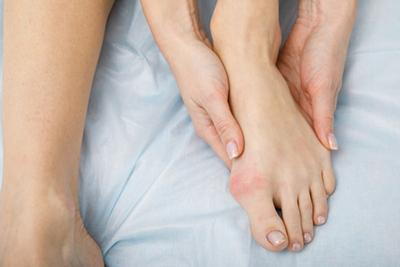Bunion Treatment Options

- posted: Sep. 01, 2023
If you have a bunion, you are not alone. A bunion is one of the most common, and painful foot problems your podiatrist can treat.
What You Need To Know About Bunions and Bunion Treatment
Bunions develop due to a genetic bone deformity in your foot, which causes the big toe joint to protrude outward. The joint begins to rub on the inside of your shoe, first causing mild irritation. The irritation turns to inflammation of your tissue, and eventually, a bunion will develop.
Bunions can be small or large, non-painful or painful, and look like a hard, bony bump on the side of your big toe. Women are more prone to bunion formation because women often wear narrow shoes with a pointed toe box, which crushes the toes together. High heels add to the problem too, because they force the toes forward, causing further pressure on the big toe joint.
If you have a small bunion, there are a few easy treatments you can try at home. You should:
- Take over-the-counter pain and anti-inflammatory medication
- Tape your foot to cushion and support the bunion
- Wear pads or inserts in your shoes
If you have a larger, more painful bunion, you need to see a podiatrist. Your podiatrist will begin with a thorough examination of your bunion and may recommend imaging studies to determine the amount of bone involvement.
To treat your bunion, your podiatrist may recommend:
- Custom orthotics to support the bunion
- Wider, more supportive footwear
- Cortisone injections around the bunion to reduce swelling
In severe cases with significant bone involvement, your podiatrist may recommend bunion surgery, also known as a bunionectomy. There are several types of bunion surgery, and your podiatrist can discuss them with you. Surgical options include:
- Surgically straightening your big toe and foot
- Fusing your toe joints
- Removing swelling and tissue around your toe joint
- Removing bone in your big toe
Want To Know More?
If you are suffering from a bunion, it can really impact your life. Your podiatrist can help. To find out more about the causes and treatments of bunions, call your podiatrist today.

- posted: Sep. 01, 2023
If you have a bunion, you are not alone. A bunion is one of the most common, and painful foot problems your podiatrist can treat.
What You Need To Know About Bunions and Bunion Treatment
Bunions develop due to a genetic bone deformity in your foot, which causes the big toe joint to protrude outward. The joint begins to rub on the inside of your shoe, first causing mild irritation. The irritation turns to inflammation of your tissue, and eventually, a bunion will develop.
Bunions can be small or large, non-painful or painful, and look like a hard, bony bump on the side of your big toe. Women are more prone to bunion formation because women often wear narrow shoes with a pointed toe box, which crushes the toes together. High heels add to the problem too, because they force the toes forward, causing further pressure on the big toe joint.
If you have a small bunion, there are a few easy treatments you can try at home. You should:
- Take over-the-counter pain and anti-inflammatory medication
- Tape your foot to cushion and support the bunion
- Wear pads or inserts in your shoes
If you have a larger, more painful bunion, you need to see a podiatrist. Your podiatrist will begin with a thorough examination of your bunion and may recommend imaging studies to determine the amount of bone involvement.
To treat your bunion, your podiatrist may recommend:
- Custom orthotics to support the bunion
- Wider, more supportive footwear
- Cortisone injections around the bunion to reduce swelling
In severe cases with significant bone involvement, your podiatrist may recommend bunion surgery, also known as a bunionectomy. There are several types of bunion surgery, and your podiatrist can discuss them with you. Surgical options include:
- Surgically straightening your big toe and foot
- Fusing your toe joints
- Removing swelling and tissue around your toe joint
- Removing bone in your big toe
Want To Know More?
If you are suffering from a bunion, it can really impact your life. Your podiatrist can help. To find out more about the causes and treatments of bunions, call your podiatrist today.
